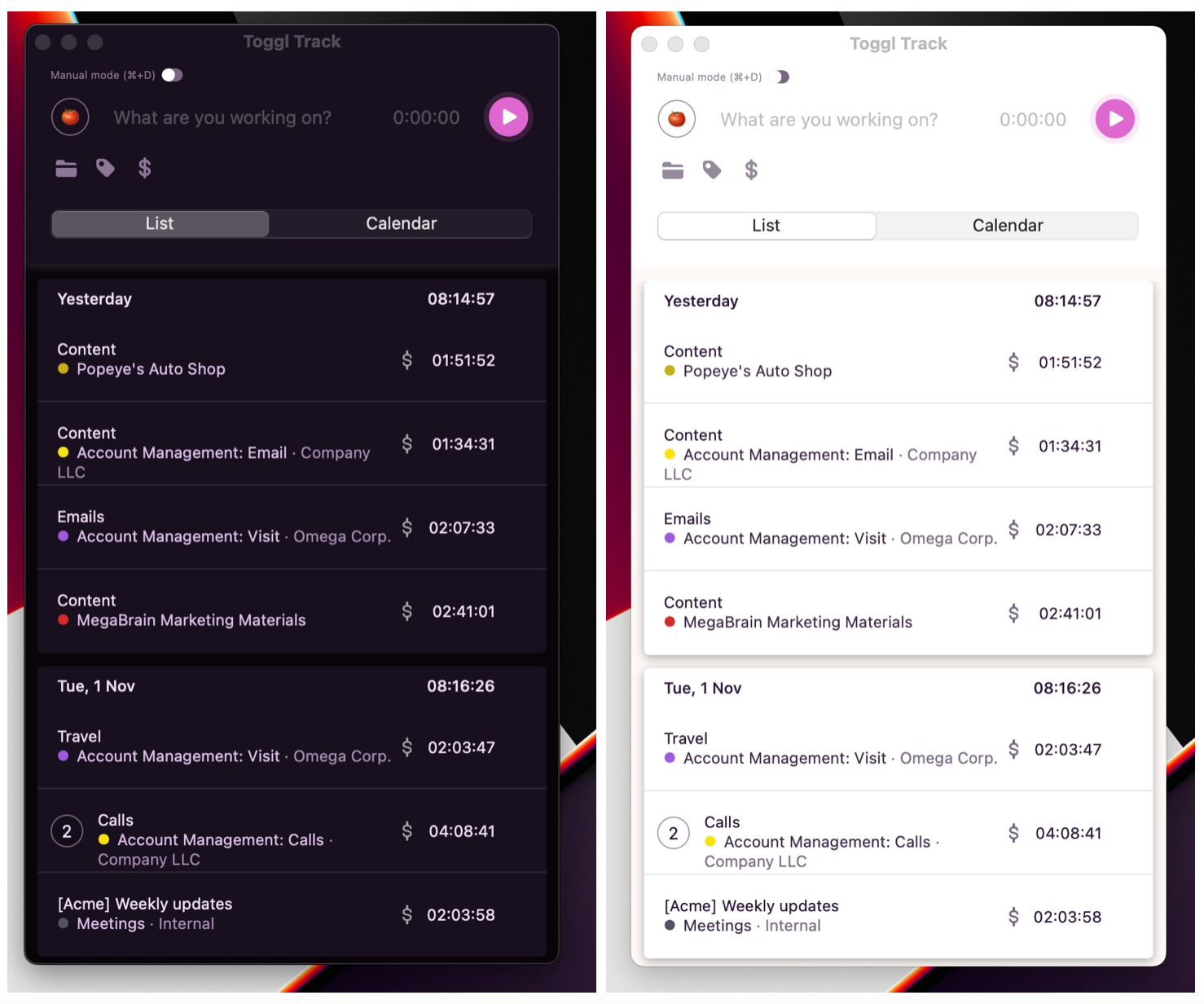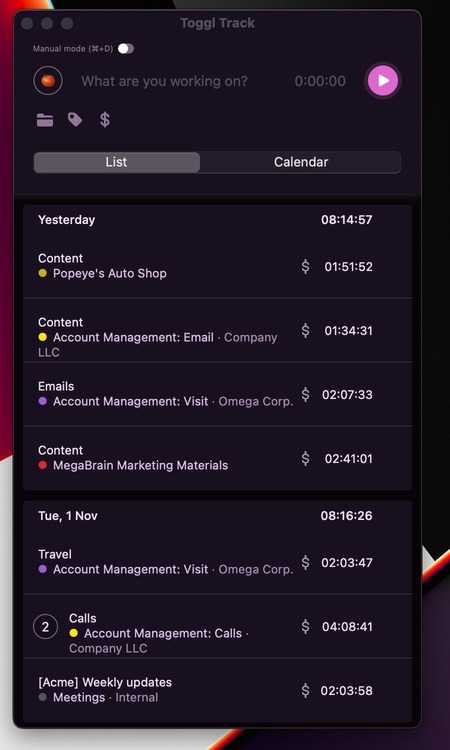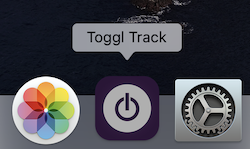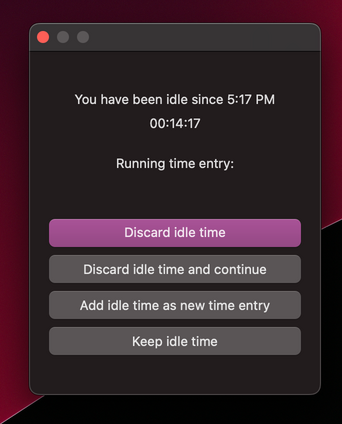Toggl Track Desktop App for macOS
Everything you need to know about the Toggl Track desktop app for macOS.
This article covers:
What is Toggl Track desktop app?
Toggl Track for Mac is a native macOS application that can be installed on your computer. It works seamlessly with the web version of Toggl Track, syncing data on the fly. The desktop app also works offline; it stores data locally and sends it to the Toggl Track server once you’re back online.
💾 Download the App

NOTE: Toggl Track will switch between Light and Dark mode based on your macOS preferences.
Tracking Time and Managing Data in List and Calendar View
The app offers two views; List and Calendar, bringing our Calendar feature into the desktop app and allowing users to add/edit time entries directly in it. Both views allow you to track and edit time entries.
List view
List-view can display each time entry individually or it can group entries with the same description and project together.
This behaviour can be controlled by enabling/disabling the “Group similar time entries” option on the Profile page. For more details about time entry grouping please open the Timer Page article.

Using the Timer
Tracking time with the desktop agent is as simple as it could possibly be.
Fill in the details of what you’re doing in the “What are you doing?” field, and click on the pink “play” button to start the timer. Use @ to enter Projects and # to enter tags in the description field. More shortcuts here.
Also on the time entry area you can see a Tomato-icon to start a Pomodoro session, and a switch to move between Timer and Manual mode.

If you start the timer first and wish to add the details later, just click on the timer and a popup window appears where you’re able to edit the description, project, tags, duration, start/stop times and the date. On paid plans, you’re also able to mark the entry as “Billable” or not.
Note: If a workspace admin has chosen to Hide start and end times, these fields will be hidden from the Timer section as well as the List view, when creating time entries in that workspace.

You can also enter details via your keyboard, using the tab button to move through fields and spacebar to make a selection.
To make it easier to differentiate, the Toggl Track desktop app icon on your dock will be pink when the timer is running, and grey when it is not. The same applies to the menu bar, but in different colors: black or transparent.

Editing time entries in List-view
Editing your time entries in the desktop app is very simple – just click on the entry you wish to edit and a small popup window will appear so you can edit the fields you wish to change. Once you’re done editing, click "Save" to save your changes.

To continue a time entry, just click on the play button next to the time entry that appears when you hover over one.
The screenshot below shows that hovering over the Time Entry with Description "Copy" will reveal a pink "play" button on the right side allowing you to continue tracking based on the details of that time entry:

If you do not wish to start a timer, you can create a manual time entry instead. Use the toggle button on the top left of the Description field to move to manual mode, or use the shortcut CMD + D.
Once in Manual mode, you can similarly enter the time entry details, and instead of starting a timer, the time entry will be saved with your chosen start/end time.
Calendar view
The Calendar view shows your tracked time in a vertical timeline side-by-side with your calendar events and timeline data. You can switch to the calendar view at the top of the main app window and navigate between specific dates. You can only view the last 8 weeks in Calendar view.
Please note: You need to enable an integration with an external Google or Outlook calendar using the Track web app first.
Time entries are shown as “pills”, color-coded to match the project they belong to on the left side of the calendar view. Information relating to your time entries is displayed while hovering over the item.

Next to them, you will see your calendar events. Hovering over an imported calendar event will reveal its details. You can right-click on a calendar event to copy it as a time entry with it's original duration or start a running timer based on that event.

At the far right of the Calendar view is the column for your Timeline activity. You can hover over these pills to see what apps you were using during that time period.
Adding time entries in Calendar view
To add a new entry, double-click on the corresponding area in the timeline to create a new entry and add details. The default duration for a time entry created in such a way is one hour, you can change that right away and click "save" in the edit view.
You can also click on an existing calendar event and either Copy as a Time Entry to create a matching time entry, or Start from Event to start a timer.

Editing time entries in Calendar view
To edit a time entry, click on it and a popup will open where you can edit details. Click save after you enter your changes. You can also drag and drop an existing time entry to a different time of the day, or resize a pill to change the duration of the time entry.

You can also right-click on existing Time Entries, and choose to either a start a new time entry after it, Continue, Duplicate or Delete it.

Adding Projects in the Desktop app
Projects can be added while creating or editing time entries, including currently running timers.
Click on the Folder icon in the Time entry area, or on the edit time entry popup and select “Add New Project”. If you type in a project name that does not exist in your Workspace, you will see that the "Create Project" button shows you an option to quickly create a project with that name.

A popup will open where you can define the project name, color (customizable colors available on paid plans only), workspace, and client. You can also choose if this project is private or not. More on creating Projects here.
Once done, click Add and this project will be saved for future use.

Syncing Data
Toggl Track syncs all your entries back to the web automatically. However, if there is an issue with the app connecting to our server you may have unsynced entries. For more details on how Toggl Track sync works, open this syncing article.
You will see a warning next to your entry in the form of a red exclamation mark or a refresh icon at the bottom right corner of the affected time entry in List-view. If this happens, navigate to the Menu bar, and click Account > Sync.
If the sync is unsuccessful, please contact our Support team by using the chat menu in the bottom right corner of this page, or email us. Please do not log out of the desktop as this will delete all unsynced time entries.
Managing Preferences
To edit the settings of your desktop app, just click Toggl Track in the menu bar and then choose Preferences or use the keyboard shortcut "CMD + ,"

Preferences are divided into 8 tabs and shown one section at a time. This is what you’ll see.
1. Preferences – General tab

Show timer on menu bar: View the running entry on the Menu bar next to the Toggl Track icon
Show Project on menu bar: View the Project for the current timer on the Menu bar next to the Toggl Track Icon
Show Description on menu bar: View the Description for the current timer on the Menu bar next to the Toggl Track Icon
Here is what this looks like:
Show dock icon: Choose whether you wish to see an icon in your macOS dock.
Open at Login: Choose whether you wish to have the app automatically opened when you log into your device.
Pin
-
Mini-timer
-
Timer
Pinning either the mini-timer or timer will display them on top of other windows on the screen.
Here is what the mini-timer looks like. Use Shift+CMD+M to enable mini-timer.

Default Project: Choose the default project to use for time entries.
Prompt running entry override: based on your selection, you will be prompted when you start a new time entry while one is running.
2. Preferences - Pomodoro

Set your intervals for Pomodoro focus and break cycles. You can also:
-
Auto-start focus sessions: When a break ends, the end focus session will start automatically.
-
Auto-start focus breaks: When a focus session ends, the break will start automatically.
-
Countdown timer: Counts down the pomodoro session timer instead of counting up.
-
Notifications: Enable/disable pomodoro notifications.
Note: Sound notifications will only be triggered if you have auto-start focus sessions or auto-start breaks enabled.
3. Preferences – Calendar

Calendar view settings can be managed from this tab. Here are the available settings:
-
Snap initial location to: 15 minutes | 5 minutes | 1 minute
-
Snap duration to: 15 minutes | 5 minutes | 1 minute
-
Activity recording: Enable timeline recording on your desktop app. You can choose to disable it, enable it and then choose what data is recorded. You can also choose whether you want the activity displayed on calendar-view, or whether you want to sync the local activity with our server or not. More on timeline here.
-
External calendars: Manage the external calendars linked to your Track account from this area.
4. Preferences - Idle

Get notified of the time that you’ve been inactive/away from the keyboard. The notification will popup after an X number of minutes as set in your preferences.
From here you can also choose what you want the app to do in specific scenarios. The options are:
-
On sleep: Do Nothing, Start Tracking Idle Time or Stop Running Time entry.
-
On shutdown: Do Nothing or Stop Running Time entry.
-
On inactivity detected: Do Nothing or Start Tracking Idle Time.
When the notification displays, you can decide whether you want to keep the time or discard it. Here’s what it looks like

The popup has four options for you to choose from:
-
Discard idle time: Discards idle time, and stops the running timer from when you went idle.
-
Discard idle and continue: Discards the idle time, but starts a new time entry that matches the previously running timer so you can resume work.
-
Add idle time as new time entry: Stops previously running timer, and adds idle time as a new time entry.
-
Keep idle time: Ignores idle time, and adds it to the currently running time entry.
5. Preferences - Reminders

Use this tab to set reminders to track time for yourself. You can choose how often you want to reminded, the window of time you wish to be reminded during, and the days of the week the reminders should be active on.
You can also snooze reminders, and choose how long the snooze period should last.
Note: If can't see any notifications from our desktop app, please make sure that Do Not Disturb is off and your system notifications for Track are enabled.
6. Preferences - Shortcuts

The Shortcuts tab allows you to set custom shortcuts:
Show/Hide Toggl: Set a global shortcut to show or hide the Toggl Track app. This will work even when the app is not in focus.
Continue/Stop Timer: Set a global shortcut to continue or stop the Toggl Track Timer. This will work even when the app is not in focus.
You can also choose if you want the app to come in focus when the timer starts or stops.
NOTE: Keep in mind that some system applications already use certain shortcuts and trying to use identical combinations of keys for global shortcuts with the Track desktop app will show you an error saying that global shortcuts need to be unique. One good example would be the "Cmd+Opt+T" shortcut used by Finder to show/hide the toolbar. You could use Cmd+Shift+T or Cmd+Ctrl+T instead.
7. Preferences - Autotracker
Setup keywords in autotracker to receive time tracking notifications for specific projects - as setup for each keyword. Autotracker is triggered based on the window title or application name.
Please note: Currently we can only detect window titles if the window is not in Full Screen mode.
8. Preferences - Account

The Account tab is where you can see your name and the email address you're logged in with. Click on My account to navigate to the Toggl Account Settings page, or click Sign out to sign out of the app. You can also close your account from here.
Keyboard Shortcuts
Toggl Track desktop app sports several keyboard shortcuts for fast time entry.
While entering a description, you can use @ to enter Projects and # to enter tags.
-
⌘ N starts a new time entry (you must be in timer mode for this)
-
⌘ D changes between timer and manual mode
-
⌘ S stops the running time entry
-
⌘ O continues the last recorded time entry (you must be in timer mode for this)
You can also click on the menu bar icon in the top right to quickly start/stop timers, sync app, go to webapp reports or send feedback.